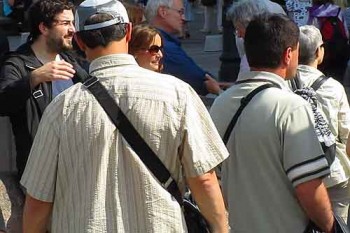
About how to spot a thief or a pickpocket, I said in my last post that “Bob and I locked onto them the moment they appeared in front of us.” Why? How did we know? What got our attention?
To everyone else in the vicinity, and there were thousands over the course of an hour, the two men appeared perfectly innocuous. Better said, they caused no one to look at them twice. So why did we?
How to spot a thief
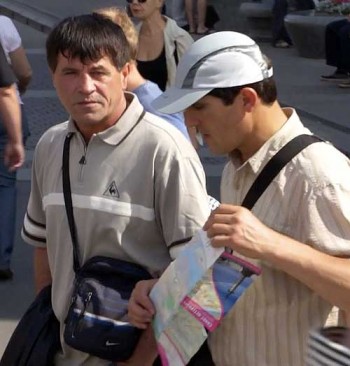
First let’s look at why no one else heard alarm bells. By design, the two blended neatly into the ever-changing crowd. They wore clean, bland, ordinary clothes. They both carried bags with the straps worn diagonally across their chests, as do many people, including their victim, and Bob, and I. They both carried jackets, as did many people, as did I. One of the men carried a tourist map—as did many people. They were clean-shaven with neat haircuts.
For all intents and purposes, they were germs hidden in full view: an invisible virus in an international organism; undetectable agents of loss.
To Bob and me, the duo stuck out like a sore thumb at first glance. In two seconds, we had each processed the following: they both wore those messenger bags—crosswise. They both carried jackets. One held a map. They walked as if they didn’t know each other. Their eyes scanned the scene around them. Their expressions revealed tension.
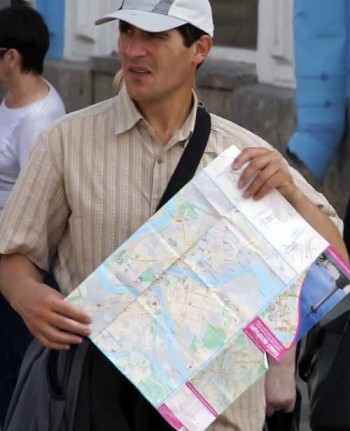
Right. That’s not much to go on. Pretty much what anyone who bothered to look would notice.
Our second stage of observation took in behavior during half a minute or so. They faked tourist gestures, including pointing into the distance and holding open their map without really looking at it. They conducted an unnatural pattern of movement; for example, reversing to walk in the direction they’d just come from, and crossing and recrossing the same street. They loitered with uncertainty and fidgetiness (I know—that’s hard to define or criticize.)
As the minutes ticked by, the pair showed further suspicious behavior. They were looping—that is, returning to a location from a different angle. They left the area on a bus, but returned on foot. They tailed a target mark, then gave up. They were persistent, trudging up and down the same block, clearly looking for something.
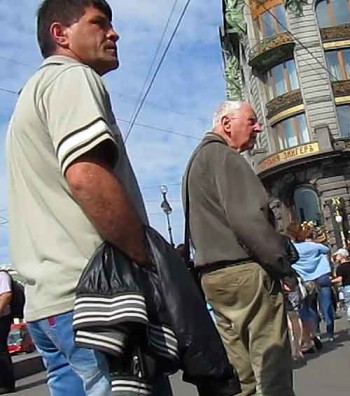
Finally, they spotted an easy target. The mark was the epitome of a victim. Elderly, alone, physically weak, discombobu-lated, and distracted. His trouser pockets were loose and gaping. His shoulder bag hung on a long strap behind his back.
The old man was immobile gazing at a shop window when they found him. Certainly the easiest game around. The pickpockets stared at him openly for several minutes. When the geezer finally moved, they closed in on him from both sides.
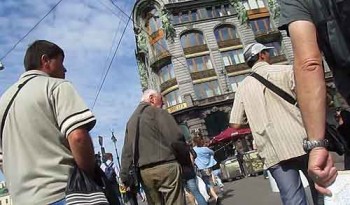
Over and over, the crowd foiled their attempts. The thieves stuck to him, though sometimes they walked past him only to stop and look back at him.
During all this, Bob was fairly stationary. He had a good angle and a long lens. I followed the action, the caboose of the parade. Sometimes when the thieves stopped I stood on the opposite side of a billboard where I could only watch their shadows or their shoes. I watched their reflections in the windows all the way across the street, or in the windows of passing cars and buses. I looked at my watch repeatedly, as if I were waiting for someone (as falsely as they held out their map). I strenuously exercised my peripheral vision muscles. When I tracked the team down past the outdoor art market, I watched them from between the paintings on display.
They became cagey. Eventually, they felt our eyes. They stared me down a few times. One covered his face as he crossed in front of Bob and his camera. But they weren’t sure about us and continued their efforts in plain sight.
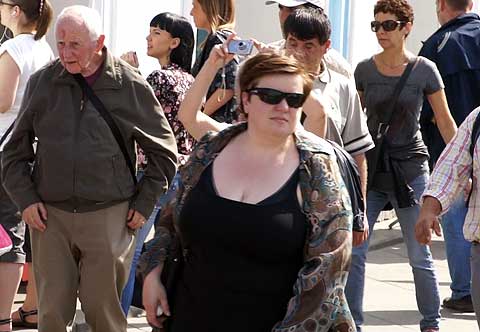
Bob and I define “pickpockets” as non-violent. “Muggers” use violence, or the threat of violence. But how do we know who we’re dealing with? We’ve been threatened by thugs in St. Petersburg before. We know that thieves in Russia often carry razor blades. Who are we to predict the level of violence these stalkers are capable of?
There’s also the drug connection. Many pickpockets are slaves to habits. What state are they in when we find them? Are they high and full of confidence? Are they coming down and desperate? Do they have creditors breathing down their necks? Have they failed so many times they’re ready to snap? Has a judge warned them that if they show their faces in his courtroom again he’ll throw the book at them?
How many are there? A “lone wolf,” a pair, a gang? Is there a controller lurking unseen on the perimeter? A spotter? A colleague with a knife who’ll step in at a whistle?
What about police protection? I mean, might the thieves have police protection? Is that what happened to us in Russia a few years ago, when we thought we were about to be robbed by pseudo cops or by real, corrupt cops? Maybe the police were just protecting the pickpockets who pay them off.
Tracking criminals is risky business. Bob and I have to weigh the various factors, sometimes in an eyeblink, and decide on our strategy. How blatant can we be? Should we continue to follow or approach the thief or gang? What have we got on us, equipment-wise? Better we slink away in the crowd? Or talk to the victim and let the thieves go?
How to spot a thief in a crowd? We don’t always make the right decision. Maybe best is when Bob and I split up. He makes contact while I blend into the crowd and keep on filming. Then his cover is blown, but not mine.






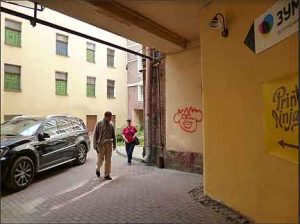
9 Comments
[…] http://bobarno.com/thiefhunters/how-to-spot-a-thief/ […]
I am a female 14 year old pickpocketer. Kind of. I have pickpocketed 3 times and have come strangely ADDICTED to it. First it was a keychain i liked. Second it was money and third it was a phone and a wallet. I don’t exactly feel right about it but when i do it and that’s why i only do it to kids at my school who i don’t like. Mesa, Velise, and Terralina. I usually “accidentaly” bump into people, them, unknowingly i have stolen their items. One time “accidentaly falling onto someone again, them unknowingly i, stealing their items. i usually carry a bag while i do it.
– Tsella Karyuin
[…] in thievery is an intentional act. It’s why you can’t spot a thief in a crowd. Picture a grandmother, a trendy teen, an older gentleman, an adorable child…. A pickpocket could […]
Hi Kevan. Most pickpockets will use something to cover their moves, but a few brave it without.
Very interesting, do you know if there are pickpockets that does not use coats of maps or anything to make a cover while stealing ?
Hello Rick! What happened to the victim? That’s all in the previous post.
So tell us what happened in this case! And FWIW I had to look up ‘discombobulated’ as I forgot what it meant. There are more syllables in that word than I can count!
Thanks for the tutorial!
interesting lesson on crime spotting. However, it is not as easy as it sounds. We have tried many times in crowded tourist areas to spot pick pockets. We know they must be there, but we have failed to spot one regardless of our efforts.
You two have the expert eagle eyes!
[…] and I locked onto them the moment they appeared in front of us. (I’ll tell you why in the next post.) To watch the team’s activity for more than a minute is to understand their motive. Bob Arno […]